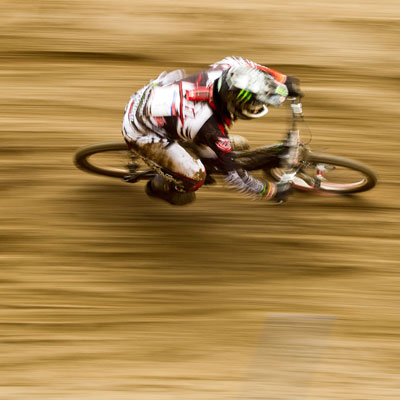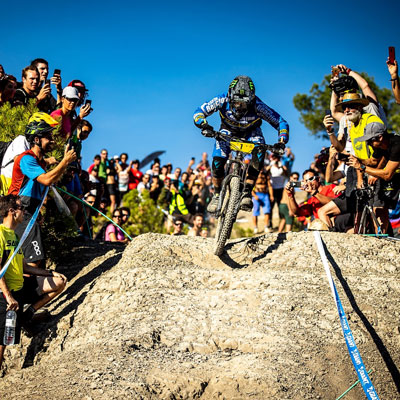Sam Hill
 SAM HILL — CHANGED HOW TO WIN A DOWNHILL RACE
SAM HILL — CHANGED HOW TO WIN A DOWNHILL RACE
Growing up racing motorcycles and BMX bikes, Sam Hill discovered mountain bikes at the age of 12 years-old. By age 16, Hill was already achieving extraordinary results in downhill mountain bike racing—earning the bronze medal at the 2001 UCI Junior Downhill World Championships in Vail, Colorado, in one of his first international races. The young Australian followed up that success with commanding, back-to-back Jr. DH World-Championship gold medal performances in 2002 and 2003.
Hill’s final junior World Champs victory (2003) would ultimately put the world on notice to his potential: Winning the junior category with a time that would have placed him in third place in the Elite category—even with a crash in his run.
Watching Hill’s 2003-junior-winning run from the chairlift, multi-time mountain bike champion Eric Carter explained, “[Hill] went through a section so fast—and it was so rocky and muddy and loose—that I couldn’t understand how he made his bike do what it did.”
All eyes were on Hill in his first year of Senior/Elite racing. Hill represented a generational talent: Riding with a new aggressive style and confidence. His approach to the course—creative line choice and how he rode those lines—was clearly different from the established competitors that came before him.
“I’m always looking for different lines,” explains Hill, “Lines that are going to give me a faster time by either carrying more speed or [that] make the track shorter by taking an ‘inside’ here or there.”
Throughout his career, Hill would win races riding lines that no other riders had either not seen—or were simply unable to ride.
His ascent to the top of the ranks was swift—scoring the bronze medal his first year in Elite at the 2004 World Championships and silver the following year in 2005, before back-to-back World Championship wins in 2006 and 2007.
While the French seemingly owned the sport in years prior—winning all but two Elite Downhill World Championships from 1994-2005 (Nicolas Vouilloz: 1995-1999, 2001, 2002; Fabien Barel: 2004-2005)—Sam Hill’s new style of racing effectively ended the French-dominated era.
Utilizing innovative and creative line choices, Hill’s rise to dominance ushered in a new era of gravity racing—with a riding style punctuated by confidence and a go-anywhere-on-the-course ability unseen before. Hill would ride lines over rocks and roots, aiming directly at the course’s most difficult features—that all other riders would choose to avoid—in undeniable fashion. His technical prowess and mental fortitude elevated the sport to new heights, and his race times were unmatched.
“When I think of Sam Hill, I think: Quiet guy,” says former World Champ Steve Peat, “But when he swings his leg over a bike, he does special things. All those years I raced against him [from 2004-2016], he definitely lifted [the competition] up a notch.”
A quiet confidence off the track simply put more attention, and credibility on his explosive riding on track. Hill’s new approach and execution altered how to win a modern DH race, while in parallel influencing product development of the era—suspension, geometry, footwear—with his riding style and his use of equipment.
Hill’s evolved style was made possible by the way he uniquely set up his bikes. His suspension setup, which seemed to be much more active over low-speed impacts, allowing more traction, than his competitor’s bikes of the time—resulting in his ability to use flat pedals, while the majority of his competitors choose clipless pedals. Through these challenges to convention and traditional setup, Hill was the embodiment of individuality and inspired a new generation of riders.
His success legitimized the first DW-link suspension system bikes and 5th Element rear shocks, forcing his competitors and an entire industry to scramble to adapt their equipment in an effort to emulate Hill’s performance. The technology boom that followed from this era produced more sophisticated compression damping systems in suspension from all brands, resulting in better performing bicycles for the masses of mountain bike consumers.
 Hill would go on to win the UCI Elite Downhill World Cup Overall series in 2007 and 2009, along with another World Championship title in 2010, before choosing to change career paths and take on an entirely new genre in 2016: Enduro.
Hill would go on to win the UCI Elite Downhill World Cup Overall series in 2007 and 2009, along with another World Championship title in 2010, before choosing to change career paths and take on an entirely new genre in 2016: Enduro.
Just one year later, in 2017, he would be at the top of another form of competition yet again, winning his first Enduro World Series overall title—while in the same year, finishing 6th at the DH Worlds on his enduro bike.
Conquering enduro competition over the next two years, Hill won the EWS World Championship title in 2018 and 2019 in an unprecedented display of his prowess on a bike—dominating in multiple forms of gravity racing, all the while evolving with the sport and helping to push advancements to better the genre. Lending his downhill credibility to the still-burgeoning genre of enduro, Hill helped promote the sport worldwide.
Sam’s ability to rewrite the formula of success in downhill and enduro racing has proven himself to be one of the sport’s all-time greats—as the only rider to win 8 of gravity racing’s most prestigious titles: Three UCI Downhill World Championships (2006, 2007, 2010), two UCI Downhill World Cup Overall titles (2007, 2009), and three Enduro World Series Overall titles (2017-2019). Sam’s influence on the sport transcends beyond his many dominating performances and championships as riders around the world continue to embrace his foot-out-flat-out mindset and the individuality that personifies modern mountain biking, regardless of the pedals they choose to ride.

